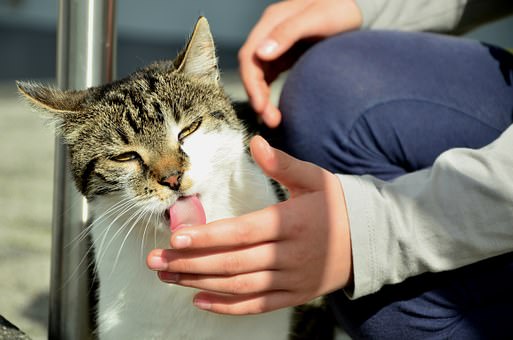We see mother cats grooming their babies and all cats grooming themselves.
We know that licking is the way that cats care for their coats, and even though we don’t have fur, our cats lick us, too!
Cats groom themselves and their kittens for hygiene and health reasons. Their rough tongues act almost like a comb to smooth out matted hair. They are also able to find and remove parasitic pests with their licking. Regular self-grooming in a cat is a sign that the cat is well because sick cats are less likely to groom themselves and can appear unkempt. We don’t often have matted hair and we don’t usually have fleas or ticks, so why would our cats lick us?
We can’t explain to our cats that we don’t have mats or bugs, but shouldn’t it seem apparent to our cats that we don’t have the same hair as they do? Maybe hair knots and pests aren’t the only reason our cats want to lick us. If we try to imagine what it’s like to be a cat and how a cat might view a human companion, the behaviors begin to make more sense.
For cats, grooming is a health necessity, but is also a bonding behavior. Social animals all have their own behavioral routines or interactions. Some people do not think of cats as particularly social, but they are. Cats can exist happily as solitary creatures, but in settings with adequate resources (like plentiful food and resting places), cats can also reside peacefully in a colony or group1.
Licking and grooming behaviors are called allogrooming and they are observed as normal interaction between cats living in groups. Cats are most likely to engage in allogrooming with their closest associates.
When your cat chooses to lick you, he is indicating not only his desire for you to be healthy and parasite-free, but also that he wants to bond with you. He likes you and values you. Whether you enjoy the licking it or not, it’s just your cat’s way of saying, “I love you.”
Join the FUR-ver by finding me on Facebook at Kathryn Primm, DVM!
- Social organization in the cat: a modern understanding. J Feline Med Surg.2004 Feb;6(1):19-28. Crowell-Davis SL, Curtis TM, Knowles RJ.


